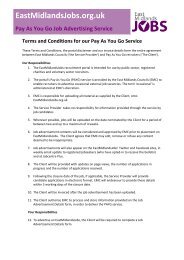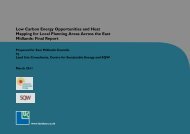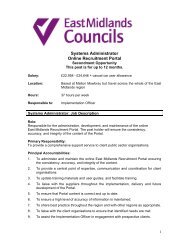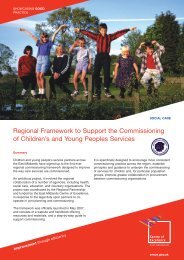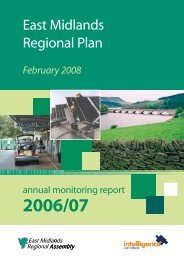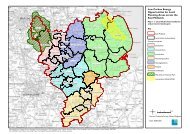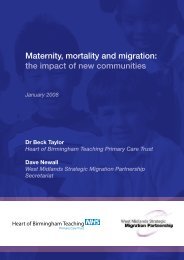East Midlands Regional Spatial Strategy 2005/06
East Midlands Regional Spatial Strategy 2005/06
East Midlands Regional Spatial Strategy 2005/06
You also want an ePaper? Increase the reach of your titles
YUMPU automatically turns print PDFs into web optimized ePapers that Google loves.
Further research and joint working with emda is<br />
needed to address urban/rural disparities and areas<br />
of significant deprivation<br />
The <strong>Regional</strong> Assembly, in discussion with the local<br />
authorities, should provide a single clear definition<br />
of the preferred areas for regeneration against<br />
which individual sites can be either included or<br />
excluded via Geographical Information Systems<br />
(GIS) plotting<br />
In order to meet the <strong>Regional</strong> Economic <strong>Strategy</strong>’s<br />
objectives for economic development it will be<br />
necessary for the regional offer of employment<br />
sites to be improved.The portfolio of sites across<br />
the region will require an emphasis on sites which<br />
will help develop key sector priorities<br />
emda has been supporting the <strong>East</strong> <strong>Midlands</strong><br />
Rural Affairs Forum (EMRAF) in the drafting of<br />
the Rural Action Plan, as well as producing an<br />
evidence base to accompany it, which draws<br />
out urban/rural disparities. A shorter evidence<br />
base was produced with assistance from<br />
Natural England to support the <strong>Regional</strong><br />
Implementation Plan, highlighting areas of<br />
environmental and socio-economic need in<br />
rural areas, to assist delivery of the Rural<br />
Development Programme for England in the<br />
<strong>East</strong> <strong>Midlands</strong><br />
Work is in progress, as part of the <strong>Regional</strong> Plan<br />
preparation, to establish and define many<br />
regional spatial boundaries where not already<br />
in place<br />
The <strong>Regional</strong> Assembly, emda and the relevant<br />
local authorities and public sector bodies are<br />
already developing and implementing<br />
strategies to improve the regional offer of<br />
employment sites to meet regional objectives.<br />
This work should continue to be seen as a<br />
regional priority with progress closely<br />
monitored<br />
<strong>East</strong> <strong>Midlands</strong> <strong>Regional</strong> <strong>Spatial</strong> <strong>Strategy</strong> Annual Monitoring Report <strong>2005</strong>/<strong>06</strong><br />
Local Authorities are urged to put in place systems<br />
and practices to ensure that the sequential location<br />
of proposed and developed retail and leisure<br />
facilities can be reported upon in future AMRs.<br />
Information from national sources such as the<br />
Valuation Office will be used to enhance the<br />
information on major developments already<br />
collected through local planning authorities<br />
The EU Water Framework Directive will be a key<br />
driver for the protection and improvement of the<br />
water environment for the next 25 years and work<br />
needs to be undertaken on how it is implemented<br />
This report contains an update on progress<br />
This year the Environment Agency has set up<br />
River Basin Management Liaison Panels on<br />
which the Region is represented. A study of the<br />
Region’s soils and their vulnerability by<br />
catchment area has been published by the<br />
Assembly as part of the study programme on<br />
land drainage, landscape and biodiversity<br />
22




